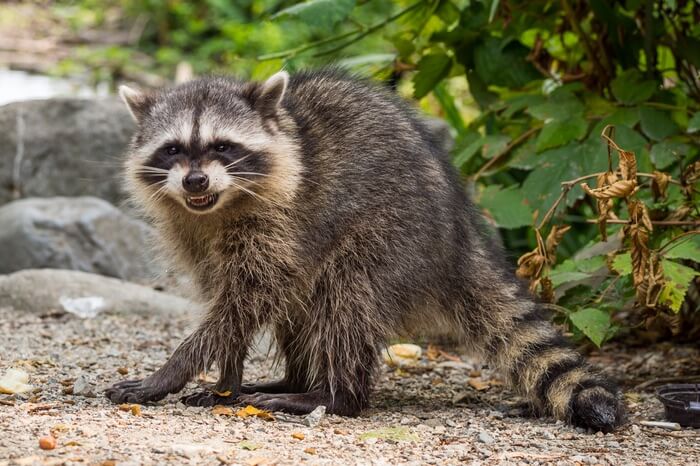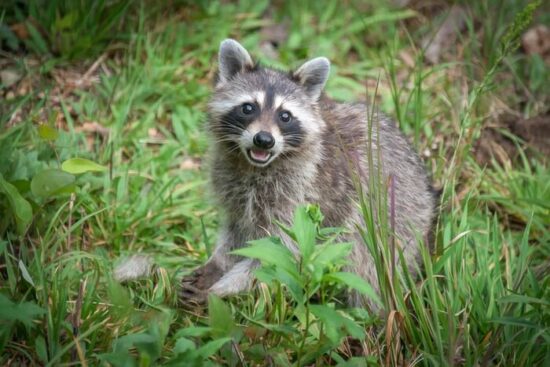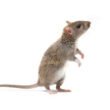Being able to identify various raccoon sounds is helpful if you want to keep these critters away from your home. Their noises and vocalizations can provide valuable information about the intention of these animals and what they’re doing on your property.
This guide will teach you what sounds raccoons make, as well as what each noise means.
Table of contents
Raccoon Sounds
Raccoons might be masters of evasion that live in the shadows, but they’re anything but silent. In addition to communicating through chemical and visual cues, these pests will make a slew of distinct vocalizations to talk to one another. These raccoon sounds are easy to miss, but you can hear them most at night when they’re most active.
Listening closely can help you identify potential raccoon infestations. You can get a better idea of where they’re hiding during the day and learn a lot about the animal’s living conditions. From their overall temperament to how many of them are hiding together, sounds can tell you a lot.
Here are some of the most common raccoon sounds and noises to listen for on your property.
Hissing
If you’re unlucky enough to catch a raccoon by surprise, you’ll likely hear hissing.
Hissing is an instinctive sound that raccoons make that’s pretty similar to what cats do when you bother them. It’s something these animals are biologically built to do.

The most significant difference between a raccoon’s hiss and a cat’s hiss is that raccoons tend to have a lower tone. It sounds a bit more intimidating, which serves the raccoon well.
Quick Tip: Raccoons aren’t particularly aggressive. They much prefer to flee and stay hidden in the shadows than face confrontation. But when they’re backed into a corner and cannot escape, they’ll try their best to be as intimidating as possible.
Hissing is one of the animal’s first lines of defense. They’ll start to make the signature noise while baring their teeth and flashing their claws.
You’re most likely to hear the sound when you encounter raccoons in your backyard. Most will flee, but some will slowly back away while hissing if an immediate escape line isn’t available. Mothers tend to hiss regardless of escape routes if young cubs, also known as kits, are around.
If you end up getting help from an extermination company or animal control, you’ll probably hear the raccoon hiss as it’s confined in a trap or cage.
Barking
When most people hear barking in the dead of night, they automatically assume it’s a dog. In reality, it very well could be the sound of a scared raccoon!
Believe it or not, raccoons have a bark that sounds eerily close to that of a small dog. Some compare it to a Chihuahua’s vocalizations, as it’s somewhat high-pitched while still having a slight edge to it. It’s just as jarring as a small canine, creating a headache-inducing sound that no one wants to deal with.
Usually, barking is an emotional response. The exact reason for the vocalization can vary quite a bit. Contextually, it seems to be a response to uncomfortable situations. Sometimes homeowners who use scents to keep raccoons away will hear barking when the smell is detected by these critters.
In many cases, these raccoon sounds are a direct result of stress, anxiety, or anger. You may hear these night bandits barking at each other whenever they get into a scuffle about food or territory. The bark acts as a warning, and the vermin’s attempt to seem scarier than it really is.
Raccoons can also start barking when they are suffering. You might hear an injured raccoon make those same vocalizations whenever they’re stuck or unable to escape a challenging predicament. Even mothers will sound like a dog if she has a hard time finding her kits.
Quick Tip: Barking can also occur out of sheer excitement! It’s not uncommon to see raccoons making the signature sound whenever they spot an abundant source of tasty food. In those cases, the barking is a little less intimidating and more jovial than normal.
Churring & Purring
The terms “churring” and “purring” are often used interchangeably. While they can be quite similar in function, these two raccoon sounds are pretty different when you hear them in person.
Purring is a noise that most people are at least vaguely familiar with. It’s the same sound that cats make. However, raccoons tend to have a much lower and more subtle purr. It’s vibrational and easy to miss unless you’re paying close attention.
Like a cat, the purring comes from the rapid movement of muscles in the larynx. The muscles move back and forth, creating vibrations that resonate out.
Churring is higher pitched. It’s akin to the whirring of a machine. Vibrant and lively, it’s a lot more noticeable than a low purr.
What do these vocalizations mean? Well, both indicate happiness.
Raccoons typically reserve purring for quiet moments of happiness or peace. It occurs when these creatures are content and safe in their surroundings. You might hear it whenever mothers are nursing their young or after a group of raccoons feast on a large meal. Some raccoons will purr when they feel content and relaxed in their hiding spot.
Churring happens when raccoons are happy as well. However, it’s more of a sporadic and uncontrollable sound. It’s almost music-like, adding a little accent to whatever trouble the raccoon is getting into.
This raccoon noise is more positive-sounding. Many compare it to computer or video game sound effects.
Screeching, Snarling, & Screaming
Here are some raccoon noises that will undoubtedly catch you off guard!
Raccoons are prone to fighting just like any other animal. When food and shelter are scarce, the claws come out. They’ll fight to the death to settle disputes and steal food. During one of these scuffles, you’ll hear all kinds of screeches and squeals.
At first, many people mistake the noise for screeching owls in the distance or fighting cats. It’s aggressive, unpredictable, and highly varied.
There’s no singular fight sound, so raccoons will utilize a mix of potential vocalizations to get their aggressive feelings across.
Either way, these sounds tend to cut through the night like nothing else! They can get pretty loud, depending on how close the raccoons are.
Quick Tip: In some cases, solitary raccoons will make the same noises. Generally, that happens whenever the animal is in distress. The sounds act as a call for help whenever the pest is injured or in immediate danger.
Growling
Growling is another guttural and harsh vocalization that raccoons do whenever they sense danger. The growl is nowhere near as intimidating as a large dog’s, but it certainly makes the animal’s presence known. To another pest, it can be downright scary!
It’s not as common to hear growling coming from raccoons. As mentioned earlier, these animals prefer to flee whenever danger is around the corner.
Growls typically only happen when the raccoon has no choice but to defend itself. It might have no obvious escape routes, or you may be dealing with a mother that cannot move her babies.
Trapped raccoons tend to growl the most. Even though they’re stuck in a cage or wire trap, they’ll still attempt to scare you off with some growling, hissing, and snorting. We don’t recommend messing with a growling raccoon.
Think of this raccoon sound as a warning to back off. If you attempt to touch the animal, it could lash out by biting or scratching you.
Chittering
Chittering is one of the more common sounds that raccoons make. They use chittering to communicate with one another, so you’re more likely to notice it when you see two or more interacting. It’s prevalent in groups, collaborative pairings, and families. You’ll witness chittering whenever two raccoons randomly run into each other as well.
Young raccoons chitter to call for their mother or siblings. Meanwhile, adults chitter when they encounter others while searching for food or shelter.
Quick Tip: The best way to describe chittering is to compare it to the sound of birds. It’s high-pitched, fast, and almost machine-like.
There’s no specific reason why raccoons chitter. Some believe that it’s the “standard” voice for communication among these animals. Other noises come out when the critter is angry, defensive, or scared.
However, chittering is the baseline that indicates neutral emotions. It’s neither happy nor aggressive. Don’t expect to hear any chittering coming your way. It seems to be an exclusive raccoon-to-raccoon sound.
What Do They Sound Like When They Move Around?
It’s not just vocalizations that you’ll hear if you come across raccoons. In fact, many homeowners won’t hear any mouth-based sounds at all!
That’s because vocalizations usually only occur when these animals are in groups or pairings. When a raccoon is by itself, it has no reason to communicate verbally. As a result, the only audible indication of their presence are noises that come from movement.
Rustling is one of the most recognizable movement sounds that raccoons will make. Known for eating trash and causing an incredible mess, most homeowners will automatically assume that any rustling they hear outside is the work of a raccoon.
These pests have agile hands with dextrous fingers. The vermin are fully capable of picking up objects. While not the most organized, they can use their hands to move garbage around in their search for food.
The sound of paper, plastic, or mental rustling around typically indicates that a raccoon has gotten into your trash bin. If they’re clever enough to find their way inside, the rustling might continue behind the walls. There, the vermin will brush against the drywall and wood framing to create the sound of movement.
Scratching is typical as well. The claws are pretty tough and versatile. Raccoons use them for everything from tearing through trash to self-defense.
They also use claws to navigate tight spaces or make their way through awkward areas. For example, you might hear the scratching as they climb down water pipes or try to squeeze their way behind the walls. Raccoons that get into chimneys and exhaust systems often leave behind tons of scratches as they make their way through.
Even trapped pests will use their claws to try and dig their way out! It’s an ear-shattering noise for some. However, the noise is very distinct and easy to identify as raccoons.
Finally, there’s dragging. This sound is just as unique as scratching and reflects the unique body shape of this mammal. Raccoons are heavy, weighing about 10 to 15 pounds. A well-fed animal can tip the scales even more!
A lot of that body mass is centralized around the midsection, creating a sizable belly that weighs the raccoon down as it walks. These trash bandits trudge along and let their body weight drag on the floor despite their agile nature.
The sound is most apparent when they’re navigating thin floors above you. It’s as if they’re crawling and dragging the body rather than walking.
Baby Raccoon Noises
Adults run the gamut as far as vocalizations and noise they make as they move. However, baby raccoons are only capable of making a limited scope of sounds.
Female raccoons typically give birth to as many as six kits after the mating season. Mothers raise the young on their own, as adult males don’t exhibit any parental skills. They’re far too violent and frequently practice infanticide.
After giving birth, females are the sole protectors of the babies. They can be a lot more aggressive as they try to raise the kits, so don’t be surprised if you hear more hissing, growling, and squealing in their presence. The mothers have no choice but to stand their ground and defend, so they are more likely to display intimidating vocalizations if you run into them.
The kits produce a slew of sounds. Some everyday noises include squeals, cooing, chirping, and mewing. Most will cry out just like a human baby, too.
Babies aren’t as discerning as adults are. They’re unaware of the potential dangers that lurk around every corner. Mothers might do their part to quiet kits, but the youngsters will make noise regardless of whether they’re safe or not.
Generally, baby raccoons make sounds and vocalize whenever they’re hungry, scared, or in immediate danger. It’s not uncommon to hear cries of fear whenever the mother leaves the nest. If the mother sets up shop under your porch, in your attic, or your home’s crawl space, you’ll likely hear them in those moments of separation.
The mothers have to leave the nest to forage for food. They’ll bring back what they can, choosing to raise the young in the safest place possible.
If you disturb the raccoon nest, mothers may attempt to move the kits. When this happens, they’ll typically begin squealing and crying when grabbed for transport. Luckily, the baby usually gets comfortable and stops after a few minutes.
That’s a good thing, as the mother has to brave many dangers as they transport the young to a new safe spot.
Sounds Of A Rabid Raccoon
Raccoons are the second most frequently reported animal to have rabies. They are second only to bats, which don’t have too big of a lead.
These pests are known carriers that can quickly spread the disease to humans and pets. All it takes is a bite or attack.
There are many ways to tell that a raccoon is rabid, and sound is one of them. They’ll make many of the same screeches, hisses, and growls as an uninfected pest. So, how can you tell the difference?
It all comes down to when those sounds occur.
Healthy raccoons usually scavenge for food on their own. When they’re alone, these animals have no reason to vocalize. They would only need to communicate if they are in danger or when they come across another scavenging raccoon.
As a result, they stay quiet.
On the other hand, Rabid raccoons will make all kinds of noise regardless of who or what is around them. They will make aggressive sounds even when no threat is present. It’s as if they’re talking to themselves, which indicates that something is wrong mentally.
It’s essential to be extra careful around raccoons. Even when they’re uninfected, these creatures can cause injuries through biting and scratching. Add rabies into the mix, and raccoons become a severe health and safety risk.
Rabies makes these bandits turn into aggressors. They’re not skittish like healthy raccoons. Instead of turning away to flee, they’ll go on the offensive.
Many rabid raccoons attack when unprovoked, so it’s important to contact animal control and let the professionals deal with any potential infestations.
Conclusion
As you can tell, there are plenty of raccoon sounds you can listen for. Each noise gives you a window into what these animals are thinking, which can be helpful if you’re trying to keep them away from your property.
Let us know if you have any questions about the various sounds raccoons make. It can sometimes be tricky to identify these noises and vocalizations in person, so we’re always happy to help.


